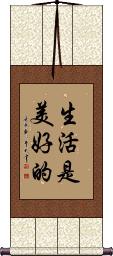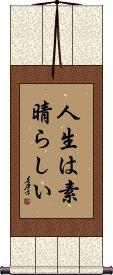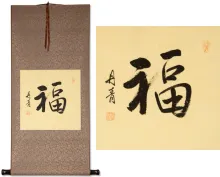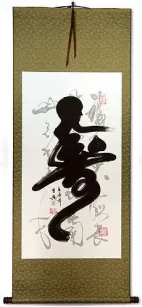Many custom options...
And formats...

Life is Good in Chinese / Japanese...
Buy a Life is Good calligraphy wall scroll here!
Personalize your custom “Life is Good” project by clicking the button next to your favorite “Life is Good” title below...
Life is Good
Life is Good
Life is Good / Life is Beautiful
人生は素晴らしい means “life is good,” “life is great,” or “life is beautiful” in Japanese.
The first two characters mean “life” (as in your or a human lifespan).
The third character kind of means “is.”
The last five characters are a long adjective that means wonderful, splendid, and/or magnificent. In the context of life, it reads more like good or beautiful.
Note: Because this selection contains some special Japanese Hiragana characters, it should be written by a Japanese calligrapher.
The Good Life / Beautiful Life
Life is Good / Life is Beautiful
This in-stock artwork might be what you are looking for, and ships right away...
Gallery Price: $61.00
Your Price: $33.88
Gallery Price: $31.00
Your Price: $16.88
Gallery Price: $65.00
Your Price: $39.88
Gallery Price: $90.00
Your Price: $49.88
Gallery Price: $61.00
Your Price: $33.88
Gallery Price: $61.00
Your Price: $33.88
Gallery Price: $61.00
Your Price: $33.88
Gallery Price: $61.00
Your Price: $33.88
Decorative Friends At Sunset Of Life
Chinese Proverb Art
Discounted Blemished
Gallery Price: $61.00
Your Price: $33.88
Gallery Price: $61.00
Your Price: $33.88
Longevity / Long Life Unique Calligraphy Scroll
Discounted Blemished
Gallery Price: $47.00
Your Price: $26.00
Gallery Price: $31.00
Your Price: $16.88
Not the results for Life is Good that you were looking for?
Below are some entries from our dictionary that may match your Life is Good search...
| Characters If shown, 2nd row is Simp. Chinese |
Pronunciation Romanization |
Simple Dictionary Definition |
達磨 达磨 see styles |
dá mó da2 mo2 ta mo daruma だるま |
More info & calligraphy: Daruma / Damodharma; also 達摩; 達麼; 達而麻耶; 曇摩; 馱摩 tr. by 法. dharma is from dhara, holding, bearing, possessing, etc.; and means 'that which is to be held fast or kept, ordinance, statute, law, usage, practice'; 'anything right.' M.W. It may be variously intp. as (1) characteristic, attribute, predicate; (2) the bearer, the transcendent substratum of single elements of conscious life; (3) element, i.e. a part of conscious life; (4) nirvāṇa, i.e. the Dharma par excellence, the object of Buddhist teaching; (5) the absolute, the real; (6) the teaching or religion of Buddha; (7) thing, object, appearance. Also, Damo, or Bodhidharma, the twenty-eighth Indian and first Chinese patriarch, who arrived in China A.D. 520, the reputed founder of the Chan or Intuitional School in China. He is described as son of a king in southern India; originally called Bodhitara. He arrived at Guangdong, bringing it is said the sacred begging-bowl, and settled in Luoyang, where he engaged in silent meditation for nine years, whence he received the title of wall-gazing Brahman 壁觀婆羅門, though he was a kṣatriya. His doctrine and practice were those of the 'inner light', independent of the written word, but to 慧可 Huike, his successor, he commended the Laṅkāvatāra-sūtra as nearest to his views. There are many names with Dharma as initial: Dharmapāla, Dharmagupta, Dharmayaśas, Dharmaruci, Dharmarakṣa, Dharmatrāta, Dharmavardhana, etc. |
三業 三业 see styles |
sān yè san1 ye4 san yeh sangou / sango さんごう |
{Buddh} (See 身口意) three activities (action, speech and thought) trividha-dvāra. The three conditions, inheritances, or karma, of which there are several groups. (1) Deed, word, thought, 身, 口, 意. (2) (a) Present-1ife happy karma; (6) present-life unhappy karma; (c) 不動 karma of an imperturbable nature. (3) (a) Good; (b) evil; (c) neutral karma. (4) (a) 漏業 Karma of ordinary rebirth; (6) 無漏業 karma of Hīnayāna nirvana; (c) 非漏非無漏 karma of neither, independent of both, Mahāyāna nirvana. (5) (a) Present deeds and their consequences in this life; (b) present deeds and their next life consequences; (c) present deeds and consequences after the next life, There are other groups of three. |
不善 see styles |
bù shàn bu4 shan4 pu shan fuzen ふぜん |
bad; ill; not good at; not to be pooh-poohed; quite impressive evil; sin; vice; mischief Not good; contrary to the right and harmful to present and future life, e. g. 五逆十惡. |
世話 see styles |
sewa せわ |
(noun, transitive verb) (1) care; looking after; help; assistance; aid; (2) trouble; bother; (noun, transitive verb) (3) good offices; recommendation; introduction; (4) everyday life; everyday affairs; everyday language; (5) (abbreviation) (See 世話物) sewamono (Edo-period drama about contemporary life) |
二果 see styles |
èr guǒ er4 guo3 erh kuo nika |
Sakṛdāgāmin; v. 裟 and 斯. The second "fruit" of the four kinds of Hīnayāna arhats, who have only once more to return to mortality. Also the two kinds of fruit or karma: (a) 習氣果 The good or evil characteristics resulting from habit or practice in a former existence; (b) 報果the pain or pleasure resulting (in this life) from the practices of a previous life. |
五果 see styles |
wǔ guǒ wu3 guo3 wu kuo goka ごか |
(1) five fruits (peach, Japanese plum, apricot, jujube, Japanese chestnut); (2) (Buddhist term) five types of effect in cause-and-effect relationships; (3) (Buddhist term) five effects of ignorance and formations on one's current life The five fruits, or effects; there are various groups, e. g. I. (1) 異熟果 fruit ripening divergently, e. g. pleasure and goodness are in different categories; present organs accord in pain or pleasure with their past good or evil deeds; (2) 等流果 fruit of the same order, e. g. goodness reborn from previous goodness; (3) 土用果 present position and function fruit, the rewards of moral merit in previous lives; (4) 增上果 superior fruit, or position arising from previous earnest endeavor and superior capacity: (5) 離繋果 fruit of freedom from all bonds, nirvana fruit. II. Fruit, or rebirth: (1) 識 conception (viewed psychologically); (2) 名色 formation mental and physical; (3) 六處 the six organs of perception complete; (4) 觸 their birth and contact with the world; (5) 受 consciousness. III. Five orders of fruit, with stones, pips, shells (as nuts), chaff-like (as pine seeds), and with pods. |
人因 see styles |
rén yīn ren2 yin1 jen yin ninin |
The causative influences for being reborn as a human being, i.e. a good life. Those in positions of honour have obtained them by former deeds of benevolence, reverence to Buddhas and monks, patience, humility, devotion to the sutras, charity, morality, zeal and exhortation, obedience, loyalty - hence they have obtained affluence, long life, and are held in high regard. Those in mean condition are thus born because of the opposite characteristics in previous incarnation. |
善人 see styles |
shàn rén shan4 ren2 shan jen yoshihito よしひと |
philanthropist; charitable person; well-doer (1) good person; virtuous person; (2) good-natured person; gullible person; (given name) Yoshihito A good man, especially one who believes in Buddhist ideas of causality and lives a good life. |
善友 see styles |
shàn yǒu shan4 you3 shan yu yoshitomo よしとも |
(rare) good friend; (personal name) Yoshitomo kalyāṇamitra, 'a friend of virtue, a religious counsellor,' M. W.; a friend in the good life, or one who stimulates to goodness. |
善果 see styles |
shàn guǒ shan4 guo3 shan kuo zenka ぜんか |
good results Good fruit from 善因 q.v.; good fortune in life resulting from previous goodness. |
堅法 坚法 see styles |
jiān fǎ jian1 fa3 chien fa kenpō |
The three things assured to the faithful (in reincarnation)—a good body, long life, and boundless wealth. |
天鼓 see styles |
tiān gǔ tian1 gu3 t`ien ku tien ku tenko てんこ |
(given name) Tenko The deva drum— in the 善法 Good Law Hall of the Trayas-triṃśas heavens, which sounds of itself, warning the inhabitants of the thirty-three heavens that even their life is impermanent and subject to karma: at the sound of the drum Indra preaches against excess. Hence it is a title of Buddha as the great law-drum, who warns, exhorts, and encourages the good and frightens the evil and the demons. |
娑婆 see styles |
suō pó suo1 po2 so p`o so po shaba; shaba しゃば; シャバ |
(1) this world; this life; (2) (kana only) (colloquialism) the free world (outside of prison, the army, red light district, etc.); (3) {Buddh} this corrupt world; present world sahā; that which bears, the earth, v. 地; intp. as bearing, enduring; the place of good and evil; a universe, or great chiliocosm, Where all are subject to transmigration and which a Buddha transforms; it is divided into three regions 三界 and Mahābrahmā Sahāmpati is its lord. Other forms: 娑婆世界; 娑界; 娑媻; 娑訶; 沙訶; 索訶. |
持犯 see styles |
chí fàn chi2 fan4 ch`ih fan chih fan jibon |
maintaining and transgressing', i. e. keeping the commandments by 止持 ceasing to do wrong and 作持 doing what is right, e. g. worship, the monastic life, etc.; transgression is also of two kinds, i. e. 作犯 positive in doing evil and 止犯 negative in not doing good. |
散業 散业 see styles |
sàn yè san4 ye4 san yeh sangō |
The good karma acquired in a life of activity. |
果報 果报 see styles |
guǒ bào guo3 bao4 kuo pao kaho かほ |
karma; preordained fate (Buddhism) (noun or adjectival noun) (1) good fortune; luck; happiness; (noun or adjectival noun) (2) {Buddh} (See 業・ごう・1) vipaka (retribution); (female given name) Kaho 異熟 Retribution for good or evil deeds, implying that different conditions in this (or any) life are the variant ripenings, or fruit, of seed sown in previous life or lives. |
死士 see styles |
sǐ shì si3 shi4 ssu shih |
person willing to sacrifice his life (for a good cause) |
活好 see styles |
huó hǎo huo2 hao3 huo hao katsuyoshi かつよし |
to live (one's life) well; (slang) to be good in bed (male given name) Katsuyoshi |
現報 现报 see styles |
xiàn bào xian4 bao4 hsien pao genpō |
Present-life recompense for good or evil done in the present life. |
白報 白报 see styles |
bái bào bai2 bao4 pai pao byappō |
Pure reward, or the reward of a good life. |
護摩 护摩 see styles |
hù mó hu4 mo2 hu mo goma ごま |
{Buddh} homa; Buddhist rite of burning wooden sticks to ask a deity for blessings homa, also 護磨; 呼麽 described as originally a burnt offering to Heaven; the esoterics adopted the idea of worshipping with fire, symbolizing wisdom as fire burning up the faggots of passion and illusion; and therewith preparing nirvāṇa as food, etc.; cf. 大日經; four kinds of braziers are used, round, semi-circular, square, and octagonal; four, five, or six purposes are recorded i.e. śāntika, to end calamities; pauṣṭika (or puṣṭikarman) for prosperity; vaśīkaraṇa, 'dominating,' intp. as calling down the good by means of enchantments; abhicaraka, exorcising the evil; a fifth is to obtain the loving protection of the Buddhas and bodhisattvas; a sixth divides puṣṭikarman into two parts, the second part being length of life; each of these six has its controlling Buddha and bodhisattvas, and different forms and accessories of worship. |
靈芝 灵芝 see styles |
líng zhī ling2 zhi1 ling chih reishi |
lingzhi or reishi mushroom (Ganoderma lucidum) The auspicious plant, emblem of good luck, or long life; name of 元照 Yuanzhao, q.v. |
青山 see styles |
qīng shān qing1 shan1 ch`ing shan ching shan seizan / sezan せいざん |
green hills; (the good) life (1) lush mountain; green mountain; (2) (せいざん only) grave; burial place; (given name) Seizan |
三善道 see styles |
sān shàn dào san1 shan4 dao4 san shan tao san zendō |
(or 三善趣) The three good or upward directions or states of existence: 天 the highest class of goodness rewarded with the deva life, or heaven; 人 the middle class of goodness with a return to human life; 阿修羅 the inferior class of goodness with the asura state. Cf. 三惡道; v. 智度論 30. |
三等流 see styles |
sān děng liú san1 deng3 liu2 san teng liu santōru |
Three equal or universal currents or consequences, i.e. 眞等流 the certain consequences that follow on a good, evil, or neutral kind of nature, respectively; 假等流 the temporal or particular fate derived from a previous life's ill deeds, e.g. shortened life from taking life; 分位等流 each organ as reincarnated according to its previous deeds, hence the blind. |
世間乘 世间乘 see styles |
shì jiān shèng shi4 jian1 sheng4 shih chien sheng seken jō |
The vehicle, or teaching for the attainment of good fruit in the present life, in contrast with 出世間乘 that for attainment in lives outside this world. |
十善位 see styles |
shí shàn wèi shi2 shan4 wei4 shih shan wei jū zen(no) gurai |
十善戒力; 十善王 The position, or power, attained in the next life by observing the ten commandments here, to be born in the heavens, or as rulers of men. |
好日子 see styles |
hǎo rì zi hao3 ri4 zi5 hao jih tzu |
auspicious day; good day; happy life |
無量壽 无量寿 see styles |
wú liàng shòu wu2 liang4 shou4 wu liang shou muryō ju |
boundless life (expression of good wishes); Amitayus, the Buddha of measureless life, good fortune and wisdom Boundless, infinite life, a name for Amitābha, as in無量壽佛; 無量壽如來; 無量壽王. |
等流果 see styles |
děng liú guǒ deng3 liu2 guo3 teng liu kuo tōru ka |
Like effects arise like causes, e.g. good from good, evil from evil; present condition in life from conduct in previous existence; hearing from sound, etc. |
Click here for more Life is Good results from our dictionary
The following table may be helpful for those studying Chinese or Japanese...
| Title | Characters | Romaji (Romanized Japanese) | Various forms of Romanized Chinese | |
| Life is Good | 人生良好 | jin sei ryou kou jinseiryoukou jin sei ryo ko | rén shēng liáng hǎo ren2 sheng1 liang2 hao3 ren sheng liang hao renshenglianghao | jen sheng liang hao jenshenglianghao |
| Life is Good | 生活是美好的 | shēng huó shì měi hǎo de sheng1 huo2 shi4 mei3 hao3 de sheng huo shi mei hao de shenghuoshimeihaode | sheng huo shih mei hao te shenghuoshihmeihaote |
|
| Life is Good Life is Beautiful | 人生は素晴らしい | jinsei wa subarashii jinseiwasubarashii jinsei wa subarashi | ||
| The Good Life Beautiful Life | 美好的生活 | měi hǎo de shēng huó mei3 hao3 de sheng1 huo2 mei hao de sheng huo meihaodeshenghuo | mei hao te sheng huo meihaoteshenghuo |
|
| Life is Good Life is Beautiful | 生活美好 | shēng huó měi hǎo sheng1 huo2 mei3 hao3 sheng huo mei hao shenghuomeihao | ||
Successful Chinese Character and Japanese Kanji calligraphy searches within the last few hours...























